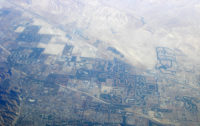The signs are hard to miss. Along freeways throughout California, digital billboards caution drivers: "Serious drought underway. Conserve water." Beyond the highways, a closer look at the landscape reveals record-low reservoir levels, smaller amounts of snowpack on mountaintops and large swaths of barren earth.
California is in the midst of its third consecutive year of drought, and state officials are worried. "We were quick to move from moderate concern to very high concern during the months of December and January, when we received record-low precipitation in many parts of the state," says Mark Cowin, director of California's Dept. of Water Resources. "It's amazing how this year has revealed how dependent we are on two or three big storm systems every year, and we've got to wait for those storm systems to move through and drop their precipitation for snowpack, and they just didn't show up this year," he says.
As a result, state leaders are moving on a number of fronts to ensure Californians have access to a reliable water supply. Conditions are even more dire in Texas. According to Robert Mace, executive administrator for the Texas Water Board's water sciences and conservation group, Texas is experiencing its second-worst drought on record.
Although droughts have occurred periodically in the American West for centuries, the latest National Climate Assessment says the sustained dry conditions are not an anomaly but the new norm, as climate change continues to cause extreme weather conditions, including severe droughts, in much of the U.S.
Construction and engineering firms that work in the water sector say they expect to see a boost in drought-related projects throughout the Southwest over the next few years. But, perhaps more importantly, they say water managers are being forced to rethink how they look at water and must consider all options to make every drop count.
These circumstances mean solutions that were once considered too expensive, energy-intensive or unpalatable for a variety of reasons—such as brackish-water and seawater desalination and indirect and direct potable reuse—are getting a second look.
"I think there is a groundswell of thinking now that we have to do something different," says Mike McKinney, district manager for PCL Construction's water-infrastructure group. "A lot of aquifers that have not traditionally had a lot of high-quality water, we are going to have to go after [them] because … that's the low-hanging fruit now [for] the next sources of water," he says, adding that he expects to see more desalination and water reclamation projects, as well.
Financial Support in California
This year, the state Legislature and Gov. Jerry Brown (D) directed the Dept. of Water Resources to expedite the award of $200 million through its Integrated Regional Water Management (IRWM) Emergency Drought Grant Program, the recipients of which were announced in late September. The state already had allocated $21.4 million toward six grant agreements, announced in February 2014, and anticipates allocating another $250.7 million in 2015. "Many of these projects will help build long-term resiliency to an extended drought," says Lauren Bisnett, a spokeswoman for the Dept. of Water Resources.
Moreover, the governor signed legislation in August that puts a $7.5-billion bond measure on the November ballot. If California voters approve the measure, the funds will go to regional districts and municipalities for drought-related projects.







